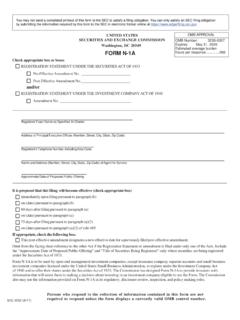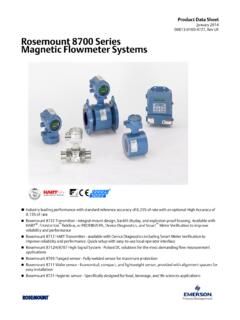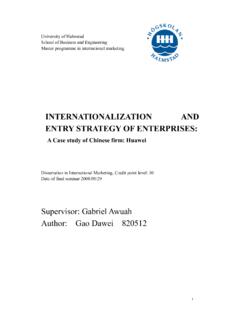Transcription of 203 - OECD
1 203 GUIDELINE FOR TESTING OF CHEMICALSA do pte d by the Co unc il o n 1 7th July 1992 Fish, Acute Toxicity new version of the guideline, originally adopted in 1981 and first updated in 1984, isbased on a proposal from the United Kingdom to reduce the numbers of fish in tests of acute aquatictoxicity. The proposal was discussed at a meeting of OECD experts convened at Medmenham (UnitedKingdom) in November main differences in comparison with the earlier versions are the reduction in group-sizeallowing the use of seven fish per group, the extension of the concentration range by allowing aspacing factor of instead of 2 and the introduction of a limit test at 100 mg/l of test OF THE fish are exposed to the test substance preferably for a period of 96 hours. Mortalities arerecorded at 24, 48, 72 and 96 hours and the concentrations which kill 50 per cent of the fish (LC50)are determined where ON THE TEST is necessary to know the water solubility of the substance under the conditions of the reliable analytical method for the quantification of the substance in the test solutions must also information includes the structural formula, purity of the substance, stability in waterand light, pKa, Pow, vapour pressure and results of a test for ready biodegradability (see Guideline 301).
2 Solubility and vapour pressure can be used to calculate Henry's constant which will indicate if lossesof the test substance may OF THE a test to be valid the following conditions should be fulfilled:-the mortality in the control(s) should not exceed 10 per cent (or one fish if less thanten are used) at the end of the test;1/9203 OCD E / OECD-constant conditions should be maintained as far as possible throughout the test and,if necessary, semi-static or flow-through procedures should be used (see Annex 1 fordefinitions);-the dissolved oxygen concentration must have been at least 60 per cent of the airsaturation value throughout the test;-there must be evidence that the concentration of the substance being tested has beensatisfactorily maintained, and preferably it should be at least 80 per cent of thenominal concentration throughout the test. If the deviation from the nominalconcentration is greater than 20 per cent, results should be based on the OF THE laboratory equipment and especially the following is necessary :(a)oxygen meter;(b)equipment for determination of hardness of water;(c)adequate apparatus for temperature control;(d)tanks made of chemically inert material and of a suitable capacity in relation to therecommended of or more species may be used, the choice being at the discretion of the testing is suggested that the species used be selected on the basis of such important practical criteria as, forexample, their ready availability throughout the year, ease of maintenance, convenience for testing andany relevant economic, biological or ecological factors.
3 The fish should be in good health and freefrom any apparent of fish recommended for testing are given in the Table. The fish mentioned in theTable are easy to rear and/or widely available throughout the year. They can be bred and cultivatedeither in fish farms or in the laboratory, under disease- and parasite-controlled conditions, so that thetest fish will be healthy and of known parentage. These fish are available in many parts of the other species fulfilling the above criteria are used, the test method should be adapted in such a wayas to provide suitable test of fish must be obtained and held in the laboratory for at least 12 days before they are usedfor testing. They must be held in water of the quality to be used in the test for at least seven daysimmediately before testing and under the following conditions:Light:12 to 16 hours photoperiod daily;Temperature:appropriate to the species (see Table);Ox yg en concentration: at least 80 per cent of air saturation value;2/9 OCD E / OECD203 Feeding:three times per week or daily until 24 hours before the test is a 48-hour settling-in period, mortalities are recorded and the following criteriaapplied:-mortalities of greater than 10 per cent of population in seven days: rejection of entirebatch;-mortalities of between 5 and 10 per cent of population: acclimatisation continued forseven additional days.
4 -mortalities of less than 5 per cent of population: acceptance of quality natural water or reconstituted water (see Annex 2) is preferred , although drinkingwater (dechlorinated if necessary) may also be used. Waters with total hardness of between 10 and250 mg CaC03 per liter, and with a pH to are preferable. The reagents used for the preparationof reconstituted water should be of analytical grade and the deionised or distilled water should be ofconductivity equal to or less than 10 solutions of the chosen concentrations are prepared by dilution of a stock solution. Stocksolutions of substances of low water solubility may be prepared by ultrasonic dispersion or othersuitable physical means. If necessary, vehicles such as organic solvents, emulsifiers or dispersants oflow toxicity to fish may be used. When such vehicles are used an additional control should beexposed to the same concentration of the vehicle as that used in the most concentrated solution of thetest substance.
5 The concentration of organic solvents, emulsifiers or dispersants should not exceed 100 test should be carried out without adjustment of pH. If there is evidence of markedchange in the pH of the tank water after addition of the test substance, it is advisable that the test berepeated, adjusting the pH of the stock solution to that of the tank water before addition of the testsubstance. This pH adjustment should be made in such a way that the stock solution concentrationis not changed to any significant extent and that no chemical reaction or precipitation of the testsubstance is caused. HC1 and Na0H are of :preferably 96 :maximum loading of g fish/litre for static and semi-static tests isrecommended; for flow-through systems higher loading can be accepted. Light:12 to 16 hours photoperiod :appropriate to the species (see Table) and constant within a range of 2 E / OECDOx yg enconcentration: not less than 60 per cent of the air saturation value.
6 Aeration can be usedprovided that it does not lead to a significant loss of test :disturbances that may change the behaviour of the fish should be of least 7 fish must be used at each test concentration and in the least five concentrations in a geometric series with a factor preferably not exceeding range-finding test properly conducted before the definitive test enables the choice of the appropriateconcentration blank and, if relevant, one control containing the solubilising agent are run in additionto the test fish are inspected at least after 24, 48, 72 and 96 hours. Fish are considered dead if thereis no visible movement ( gill movements) and if touching of the caudal peduncle produces noreaction. Dead fish are removed when observed and mortalities are recorded. Observations at threeand six hours after the start of the test are desirable.
7 Records are kept of visible abnormalities ( of equilibrium, swimming behaviour, respiratory function, pigmentation, etc.). Measurement ofpH, dissolved oxygen and temperature should be carried out at least the procedures described in this Guideline, a limit test may be performed at 100mg(active ingredient)/l in order to demonstrate that the LC50 is greater than this concentration. Thelimit test should be performed using a minimum of 7 fish, with the same number in the control(s).(Binomial theory dictates that when 10 fish are used with zero mortality, there is a % confidencethat the LC50 is greater than 100 mg/l. With 7, 8 or 9 fish, the absence of mortality provides at least99% confidence that the LC50 is greater than the concentration used in the limit test.) If anymortalities occur, a full study should be conducted. If sublethal effects are observed, these should AND REPORTINGT reatment of cumulative percentage mortality for each exposure period is plotted against concentrationon logarithmic probability paper.
8 Normal statistical procedures are then employed to calculate theLC50 for the appropriate exposure period. Confidence limits (p = ) for the calculated LC50values are determined using standard procedures (1)(2)(3)(4)(5).4/9 OCD E / the data obtained are inadequate for the use of standard methods of calculating theLC50, the highest concentration causing no mortality and the lowest concentration producing 100 percent mortality should be used as an approximation for the LC50 (this being considered the geometricmean of these two concentrations).Test test report must include the following information:Test substance:-physical nature and, where relevant, physicochemical properties;-identification fish:-scientific name, strain, size, supplier, any pretreatment, conditions:-test procedure used ( static, semi-static, flow-through; aeration; fish loading;etc.);-water quality characteristics (pH, hardness, temperature);-dissolved oxygen concentration, pH values and temperature of the test solutionsat 24 hour intervals (in semi-static systems the pH should be measured prior toand after water renewal);-methods of preparation of stock and test solutions;-concentrations used;-information on concentrations of the test substance in the test solutions;-number of fish in each test :-maximum concentration causing no mortality within the period of the test;-minimum concentration causing 100 per cent mortality within the period of thetest;-cumulative mortality at each concentration at the recommended observation times;-LC50 values, with 95 per cent confidence limits, at each of the recommendedobservation times, if possible; -graph of the concentration-mortality curve at the end of the test.
9 -statistical procedures used for determining the LC50 values;-mortality in the controls;-incidents in the course of the test which might have influenced the results;-abnormal responses of the of the E / OECDTABLE: FISH SPECIES RECOMMENDED FOR TESTINGR ecommended speciesRecommended testte mperature rang e(oC)Recommended total length oftest fish(cm)1 Brachydanio rerio(Teleostei, Cyprinidae) (Hamilton-Buchanan) Zebra-fish21 - + promelas(Teleostei, Cyprinidae)(Rafinesque) Fathead Minnow 21 - + carpio(Teleostei, Cyprinidae) (Linnaeus)Common carp20 - + latipes(Teleostei, Cyprinodontidae)(Temminck and Schlegel) Ricefish21 - + reticulata(Teleostei, Poeciliidae) (Peters)Guppy21 - + macrochirus(Teleostei, Centrarchidae)(Rafinesque) Bluegill21 - + mykiss(Teleostei, Salmonidae) (Walbaum)Rainbow trout13 - + 1 If fish of sizes other than those recommended are used, this should be reported together withthe E / OECD203 LITERATURE(1)Litchfield and Wilcoxon F.
10 (1949). A simplified method of evaluating dose-effectexperiments. J. Pharmacol and Exper. Ther., 96, 99-113.(2)Sprague (1969). Measurement of pollutant toxicity to fish. I Bioassay methods for acutetoxicity. Water Res. 3, 793-821.(3)Sprague (1970). Measurement of pollutant toxicity to fish. II Utilising and applyingbioassay results. Water Res. 4, 3-32.(4)Stephan (1977). Methods for calculating an LC50. In Aquatic Toxicology and HazardEvaluation (edited by Mayer and Hamelink ). ASTM STP 634, pp 65-84, AmericanSociety for Testing and Materials.(5)Finney (1978). Statistical Methods in Biological Assay. Griffin, Weycombe, E / OECDANNEX 1 DEFINITIONSS tatic test is a test with aquatic organisms in which no flow of test solution occurs. Solutions remainunchanged throughout the duration of the test is a test without flow of solution, but with occasional batchwise renewal of the testsolution after prolonged periods ( 24 hours).














